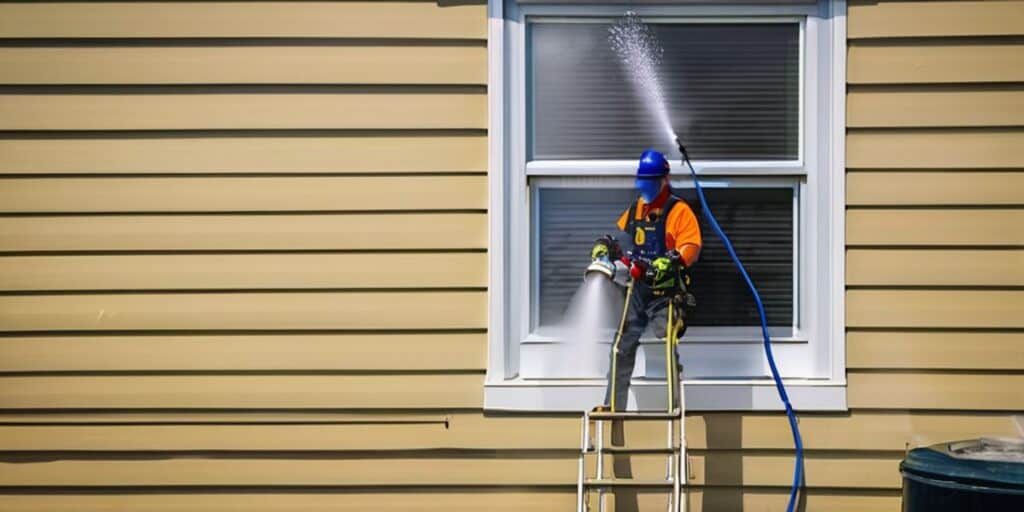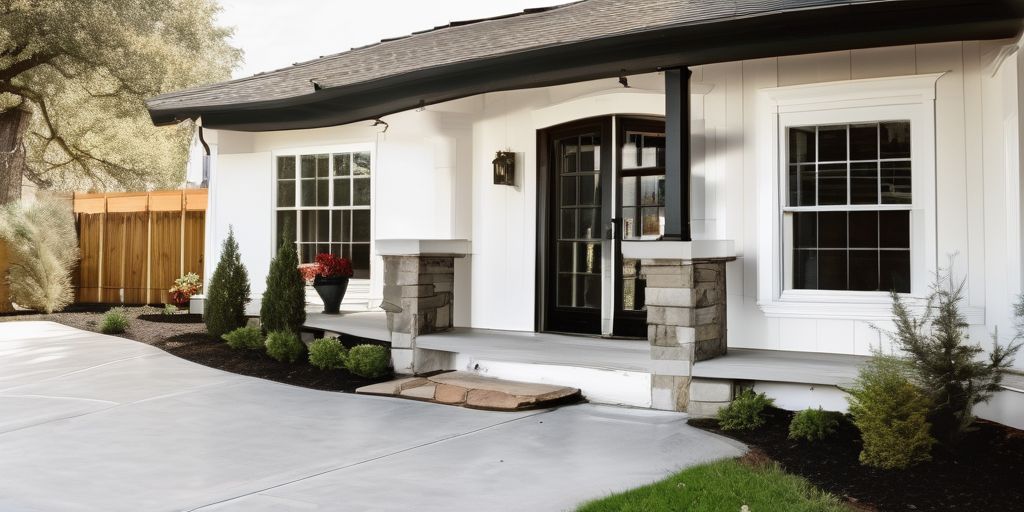Aluminum siding is a durable and attractive option for many homes, but like any exterior surface, it requires proper preparation before painting to ensure the best results. This article will guide you through the essential steps of preparing and cleaning aluminum siding for painting, from gathering the necessary supplies to applying the right type of paint for a lasting finish. With attention to detail and adherence to best practices, you can achieve a professional-quality paint job that not only looks great but also stands up to the elements.
Key Takeaways
- Ensure all surfaces are clean, free of dust, grease, and peeling paint before starting the painting process, using a non-soapy detergent or TSP substitute for washing.
- Remove any gloss from existing paint by sanding thoroughly and wipe down with denatured alcohol to achieve maximum adhesion for the new paint.
- Choose the right type of paint for aluminum siding, preferring a high-quality, waterproof, oil-based paint without ammonia for compatibility and durability.
- Apply Awl-Wash Primer CF correctly within 4 hours of cleaning, and allow for at least 1 hour before overcoating with other primers for optimal adhesion.
- Assess the compatibility of the existing paint with the new one and prepare the surface by removing all loose paint and contaminants before applying the new coat.
Getting Started: Essential Supplies and Surface Preparation
Gathering Your Materials
Before diving into the task of painting your aluminum siding, it’s crucial to have all the necessary materials at hand. Ensure you have a comprehensive toolkit to facilitate a smooth and efficient painting process. Here’s a list of essential items you’ll need:
- Tape Measure
- Speed Square
- Sharpies for marking
- Aviation Snips
- Reciprocating Saw
- Impact Gun
- Safety Gear including goggles and gloves
Remember, a well-prepared setup is the foundation of a professional aluminum siding painting process. It includes thorough cleaning with a power washer, using extension wands, and ensuring surfaces are dry before painting. This preparation is key to achieving the best results.
Safety is paramount. Always wear appropriate safety gear and follow the manufacturer’s instructions for each tool and material you use.
Ensuring a Clean Surface
Before you can start painting, ensuring a clean surface is crucial. Dirt, grease, and any other contaminants can prevent paint from adhering properly, leading to a finish that’s less than ideal. Here’s how to get your aluminum siding ready for a fresh coat:
- Step 1: Remove any loose debris with a soft brush or cloth.
- Step 2: Wash the surface with a mild detergent solution to remove dirt and grime.
- Step 3: Rinse thoroughly with clean water to remove any soap residue.
Remember, a pristine surface is the canvas for your paint. After cleaning, inspect the siding for any signs of damage or areas that may need special attention. Repairing and masking off these areas will contribute to a professional-looking finish.
Proper preparation is key for long-lasting aluminum siding painting. Use power washing, sanding, repairing, and masking techniques. Apply high-quality paint with even coverage for a durable finish.
Addressing Peeling and Glossy Surfaces
When preparing aluminum siding for painting, it’s crucial to address any areas where the paint is peeling or the surface is too glossy. Properly prepare aluminum siding by identifying rough spots, choosing the right sanding method, and cleaning effectively. Here’s how to tackle these issues:
- Peeling Paint: Remove loose or peeling paint with a scraper or wire brush. Sand the edges to feather them into the existing paint for a smooth transition.
- Glossy Surfaces: Dull glossy finishes by lightly sanding with fine-grit sandpaper. This will help the new paint adhere better.
Remember, a well-prepared surface is key to ensuring that your new paint job will last. Consider local conditions for successful paint adhesion and durability.
After addressing these areas, clean the siding with a solution of water and trisodium phosphate (TSP) to remove any remaining debris and provide a clean surface for the primer to adhere to. Choose quality tools and paint, consider weather conditions, and avoid rushing the process for a professional, long-lasting finish.
The Cleaning Process: Achieving a Pristine Surface
Washing with Detergent Solutions
When it comes to maintaining the integrity and appearance of your aluminum siding, the right cleaning approach is crucial. Start with a mild detergent solution to gently lift dirt and grime without damaging the surface. Here’s a simple guide to creating an effective cleaning mixture:
- Mix warm water with a mild detergent, such as dish soap or a dedicated aluminum siding cleaner.
- For tougher stains, add a small amount of vinegar or baking soda to the solution.
- Use a soft-bristled brush to apply the solution, scrubbing gently to avoid scratching the aluminum.
Remember to always rinse the siding thoroughly with clean water after washing to remove any soap residue. This step is essential to prevent any potential buildup that could affect the paint’s adhesion.
Proactive maintenance, including regular cleaning, can significantly extend the life of your aluminum siding. Stay vigilant against common issues like rust or ivy, which can cause long-term damage if left unchecked.
For a detailed guide to aluminum-friendly cleaners and additional tips for maintaining your siding, refer to the list below:
- Use a mild degreaser for areas with heavy buildup.
- Apply a rust remover to any spots showing signs of corrosion.
- Conduct regular inspections to catch and address any potential problems early.
Using Power Washers for Stubborn Dirt
When your aluminum siding is marred by stubborn dirt and grime, a power washer can be a game-changer. Ensure that the washer is set to a moderate pressure to avoid damaging the siding. Here’s how to effectively use a power washer:
- Start by wetting the siding with plain water to prevent the detergent from drying too quickly.
- Apply a mixture of detergent, degreaser, and water to the siding. For tough stains, commercial cleaners may be necessary.
- Use smooth, overlapping strokes with the power washer, keeping the nozzle at least 12 inches away from the siding.
- Rinse thoroughly with clean water to remove all detergent and loosened dirt.
Remember, regular inspections and care of your aluminum siding will enhance its longevity and appearance.
After power washing, let the siding dry completely before moving on to any further surface preparation or painting. This step is crucial for a durable and flawless paint finish.
Drying and Dust Removal
Once you’ve thoroughly washed your aluminum siding, the next crucial step is drying and dust removal. This ensures that no water spots or debris compromise the paint’s adhesion and finish. Here’s how to achieve a perfectly dry and dust-free surface:
- Use a clean, soft towel or microfiber cloth to gently blot and wipe down the siding. Avoid vigorous rubbing which can leave streaks.
- Allow the siding to air dry completely. This may take several hours, depending on weather conditions.
- After the siding is dry, go over the surface with a tack cloth or a damp sponge to pick up any remaining dust particles.
Remember, a pristine surface is key to a professional-looking paint job. Ensuring that all moisture and dust are removed will help in maintaining the longevity and sheen of your newly painted siding.
By following these simple steps, you’re setting the stage for a successful painting project. The effort you put into preparing the surface will be evident in the quality of the finished product.
Sanding Techniques for Aluminum Siding
Choosing the Right Sandpaper
When preparing aluminum siding for painting, the choice of sandpaper is crucial for achieving a smooth and receptive surface. Selecting the correct grit is essential for effective sanding without damaging the material. Here’s a quick guide to help you choose:
- 60–100 grit is ideal for removing old paint or preparing the surface for antifouling paint.
- For a finer finish, especially on areas like stripes, 220 grit sandpaper is recommended.
After sanding, it’s important to remove any residue to ensure a clean surface for painting:
- Wipe the area with a cloth dampened with the appropriate solvent.
- If you’ve used masking tape, remove it carefully to avoid leaving adhesive behind.
- A second round of masking can lead to a sharper finish, so take your time with this step.
Remember to always work in a well-ventilated area and wear protective gear to avoid inhaling dust or fumes.
Masking Tape plays a pivotal role in achieving clean lines and protecting areas from accidental paint application. Use high-quality tape for best results, especially if it will remain on the surface for an extended period.
Removing Gloss and Smoothing Out Surfaces
Achieving a surface that’s ready for paint involves more than just a quick wipe-down. Removing the gloss from your aluminum siding is a critical step to ensure that the new paint adheres properly and looks its best. Here’s how to tackle this task effectively:
- Start by sanding the glossy areas with fine-grit sandpaper. This will help to dull the surface and create a better grip for the primer and paint.
- Be sure to sand evenly to avoid creating scratches or uneven areas that could show through the paint.
- After sanding, it’s important to remove all dust and debris. A tack cloth or damp rag can be used to wipe down the surface.
Professional advice is recommended for painting aluminum siding to ensure long-term protection. Steps include thorough cleaning and repairing damaged areas for a durable and aesthetically pleasing finish.
Remember, proper preparation is key for painting aluminum siding. Sanding and priming are essential for adhesion and durability. Choose high-quality paint and maintain regularly for a long-lasting finish.
Wiping Down with Denatured Alcohol
After sanding your aluminum siding, it’s crucial to remove any residual dust and oils that could interfere with primer adhesion. Wiping down with denatured alcohol is an effective way to ensure a clean, receptive surface for priming. Here’s how to do it properly:
- Begin by lightly dampening a clean, lint-free cloth with denatured alcohol.
- Gently wipe the sanded areas, making sure to cover the entire surface evenly.
- Frequently switch to a clean side of the cloth to avoid re-depositing any contaminants.
- Allow the surface to dry completely before moving on to priming.
Remember, patience is key during this stage. Rushing through the preparation can compromise the durability and finish of your paint job.
By following these steps, you’re setting the stage for better adhesion and a professional finish. It’s a simple yet vital part of the guide to sanding and priming aluminum siding for a lasting result.
Priming for Perfection
Selecting the Appropriate Primer
Selecting the right primer is crucial for ensuring that your aluminum siding holds paint well and withstands the elements. The primer acts as an intermediary layer that helps the paint adhere to the siding and prevents peeling. Here are some tips for choosing the best primer for your project:
- Look for primers specifically designed for use on metal surfaces, as they will provide better adhesion and protection.
- Consider the local climate and the expansion and contraction rates of the materials. A primer that works well with the siding and the paint will accommodate these changes without cracking or peeling.
- If your siding has imperfections such as scrapes or gouges, a medium build primer like Awlquick can help fill these in.
When applying primer, remember that a clean and well-prepared surface is key to achieving the best results. Apply the primer within the recommended time frame after cleaning to ensure optimal adhesion.
For aluminum siding, you may encounter options such as 545 Epoxy Primer, which is a thin, building primer suitable for relatively smooth surfaces. Alternatively, Awlquick is a medium build primer/surfacer that’s ideal for surfaces needing additional filling. Below is a comparison to help you decide:
| Primer Type | Surface Condition | Application Method |
|---|---|---|
| 545 Epoxy Primer | No filling required | Roller or Spray |
| Awlquick | Filling scrapes/gouges | Roller or Spray |
Remember, the application method can also influence your choice of primer. Some primers are best applied with a roller and then tipped off with a brush, while others may be suitable for spraying. Always follow the manufacturer’s instructions for the best outcome.
Applying Awl-Wash Primer CF
Once your aluminum siding is clean and dry, it’s time to apply the Awl-Wash Primer CF. This primer is essential for ensuring excellent adhesion to the aluminum surface and should be mixed from Part A and Part B. Apply the primer within 4 hours of cleaning to achieve the best results. After application, the primer can be overcoated with other primers in as little as 1 hour, but make sure to do so within 6 months to avoid the need for sanding.
When it comes to choosing a primer to apply over the Awl-Wash Primer CF, you have two main options:
- 545 Epoxy Primer: A thin, building primer suitable when there’s no need to fill scrapes or gouges.
- Awlquick: A medium build primer/surfacer, perfect for surfaces that require filling due to scrapes or gouges. It consists of Awlquick Base + Converter.
Remember, the choice of primer will depend on the condition of your siding and the finish you desire. Choose wisely to ensure a durable and appealing finish.
Once the primer is set, you’re ready to move on to the topcoat. Whether you choose Awlgrip, which can be brush rolled or sprayed and typically lasts 7-10 years, or Awlcraft, which must be sprayed and usually lasts 4-6 years, both options offer excellent resistance to fading, chalking, weathering, and corrosion.
Timing and Recoating Considerations
Once you’ve applied the primer, timing is crucial for the best results. Here’s a quick guide to help you navigate the recoating process:
- After applying the first coat of Awlgrip HDT, wait for it to flash off for 30-45 minutes, depending on the conditions.
- Go ahead with a slightly heavier second coat. If necessary, a third coat can be added to achieve the desired Dry Film Thickness (DFT).
Remember, the goal is to achieve meticulous cleaning, residue removal, sanding, priming, and high-grade paint selection for lasting beauty and protection of your aluminum siding.
For the topcoat:
- Only mix as much paint as you can use in 30 minutes to avoid waste.
- Keep the painted surface dry for at least 24 hours post-application.
- Allow a full 7-10 days for the paint to cure completely before exposing it to harsh conditions.
Avoid using flow control agents, as they can affect the integrity of the paint. For a detailed breakdown of drying and recoating times, see the table below:
| Number of Coats | Dry Time | Recoat Time | Full Cure |
|---|---|---|---|
| 1 or 2 | 1 hour | 4 hours | 14 days |
By adhering to these guidelines, you ensure superior outcomes and extend the life of your aluminum siding.
Choosing and Applying the Right Paint
Picking the Perfect Gutter Paint
When it comes to giving your gutters a fresh, new look, the choice of paint is crucial. Select a high-quality, waterproof exterior paint that will stand up to the elements and adhere well to your gutters. For vinyl gutters, an acrylic option is best, while aluminum gutters benefit from an oil-based paint. Remember, the paint should be free of ammonia to ensure the integrity of your gutters.
It’s essential to match the paint color with the rest of your home’s exterior to create a cohesive appearance. Whether you’re complementing painted vinyl siding or an exterior brick stain, the right color can enhance your home’s curb appeal significantly.
When undertaking the task of refreshing your gutters, consider the weather conditions. The ideal time for painting is during clear skies and low humidity, which aids in proper drying and curing of the paint.
Here’s a quick checklist of supplies you’ll need for the job:
- Paint stripper
- Cleaning rags
- Denatured alcohol
- Sandpaper (aluminum oxide or silicon)
- Waterproof, acrylic paint (for vinyl gutters)
- Waterproof, oil-based paint (for aluminum gutters)
- Flex additive
- Gutter detergent (optional)
By following these guidelines, you can properly assess, clean, and paint your aluminum siding, ensuring longevity and aesthetic appeal.
Understanding Compatibility with Existing Paint
When it comes to repainting aluminum siding, ensuring compatibility between the new paint and the existing layer is essential. Here’s a simple guide to help you through the process:
- First, identify the type of paint currently on the siding. If it’s compatible with your new choice, you can proceed with sanding, priming, and painting.
- If not, you’ll need to remove the old coating. This often involves sanding with coarse (80 grit) paper until the old paint is completely removed. Remember, sandblasting is not recommended as it can damage the aluminum.
Performing an adhesion test is a smart move before fully committing to painting a large area. Apply a small test section of the topcoat and let it dry. Then, conduct a hatch test with a razor blade to check for proper adhesion.
It’s important to note that using water-based latex paint over multiple coats of old alkyd or oil-based paint can lead to adhesion issues. In such cases, it might be necessary to remove the existing paint entirely or use another coat of alkyd or oil-based paint.
Application Tips for a Lasting Finish
Achieving a lasting finish on aluminum siding is not just about the paint you choose, but also how you apply it. Proper application techniques are crucial for durability, aesthetics, and sustainability. Here are some tips to help you ensure a finish that stands the test of time:
- Preparation: Before applying the final coat, lightly sand the surface to create a smooth texture and promote adhesion.
- Technique: Apply the paint in thin, even coats using a brush, roller, or spray gun. This helps prevent runs and drips and ensures even drying.
- Drying: Allow each coat to dry completely before applying the next. Adhering to the manufacturer’s recommended drying time is essential.
Remember, applying paint unevenly or too thinly can result in a weak bond that may crack, peel, or fade prematurely. For a smooth uniform appearance, brush or roll from wet to dry areas, and plan for interruptions at a natural break, such as a window, door, or corner.
Use a high-quality brush or roller for an even application and keep the paint mixed well throughout the process to maintain consistency.
Fluoropolymer paints are a cost-effective and long-lasting protection for aluminum siding, especially in polluted areas. With the right preparation and application, you can achieve a durable and beautiful finish.
When it comes to giving your home a fresh, new look, choosing the right paint and applying it correctly is crucial. At We Paint Siding, we specialize in transforming your aluminum siding with high-quality spray painting that ensures uniform coverage, durability, and a professional finish. Don’t settle for less; let us revitalize your home’s exterior efficiently and effectively. Ready to see the difference? Visit our website to book your free estimate and explore our extensive range of painting services. Your home deserves the best, and we’re here to deliver it with precision and care.
Conclusion
In wrapping up, the journey to revitalize your aluminum siding with a fresh coat of paint is one that requires attention to detail and a methodical approach. From the initial cleaning to the final brush stroke, each step plays a crucial role in ensuring a durable and visually appealing finish. Remember to choose the right supplies, from paint strippers to the correct type of sandpaper, and to select a high-quality paint that complements your home’s exterior. Whether you’re tackling tough dirt with a power washer or meticulously sanding down glossy surfaces, your efforts will pay off when you see your siding transformed. By following the best practices outlined in this guide, you’ll not only enhance the curb appeal of your property but also protect it against the elements. Happy painting!
Frequently Asked Questions
What supplies do I need to prepare and clean aluminum siding before painting?
You will need paint stripper, cleaning rags, denatured alcohol, aluminum oxide or silicon sandpaper, and gutter detergent (optional) for cleaning. For painting, you’ll require waterproof, acrylic paint for vinyl gutters or waterproof, oil-based paint for aluminum gutters, along with a flex additive.
How should I clean the gutters before painting?
First, wash off all surface dirt with a scrub brush and detergent solution, followed by a thorough rinsing with a garden hose. For heavier dirt, use a power washer. Ensure the gutters are completely dry after cleaning.
What sanding technique should I use for aluminum siding?
Use aluminum oxide or silicon sandpaper to sand out any gloss, rough spots, or areas of remaining paint. After sanding, wipe the gutters down with denatured alcohol and let them dry fully before applying primer and paint.
How do I apply Awl-Wash Primer CF to aluminum siding?
Mix Part A and Part B of Awl-Wash Primer CF and apply it within 4 hours of cleaning the surface. It can be overcoated with primers after 1 hour of application, and the maximum recoat time without sanding is 6 months.
How do I choose the right paint for aluminum siding?
Select a high-quality, waterproof exterior paint that is compatible with the material of your gutters (acrylic for vinyl or oil-based for aluminum) and does not contain ammonia. Choose a color that matches your home’s exterior.
What should I do if the existing paint on my aluminum siding is not compatible with new paint?
If the existing paint is not compatible, it needs to be completely removed. Sand the surface with 80 grit sandpaper until the old coating is gone. Avoid sandblasting as it can damage the aluminum itself.










